- Punjab farmers planning Delhi style protests against water crisis & Centre. FAQ tells how Punjab got its name, where 5 rivers originate, cause of water crisis & provisions of Indus Water Treaty.
- Under-utilization of waters under treaty requires National Attention.
According
to a November
15 report in Tribune, Chandigarh farmers of five unions were going to have Delhi style morcha in
Mohali against water crisis, environmental pollution and attack on the federal
structure of the state.
One of their leaders Rajewal said, “A state of rivers, Punjab is deprived of water and only 27 per cent land is irrigated by canals. Much water is flowing to Pakistan and other states due to wrong policies and decisions of the Central government. “The Central government’s interference on the issue is illegal and unconstitutional because water is the state subject (Entry 17 of the state list). Leaders are of the view that Punjab has the first right on water.”
These statements triggered this article. Modern day Punjab is no longer the land of rivers. One hopes that state and Central governments communicate the new reality and not allow ignorance to escalate into protests.
For easy reading covering all issues in a FAQ format.
Q1. Punjab (Punj means five) is said to be the land of five
rivers. Which are these?
A1.
The rivers are Ravi, Chenab, Sutlej, Beas and Jhelum.
 Map shows rivers.
Map shows rivers.
Q2. Where do we these five rivers originate?
A2.
Sutlej originates in Tibet and flows
through Himachal. Bhakra Dam was built on it.
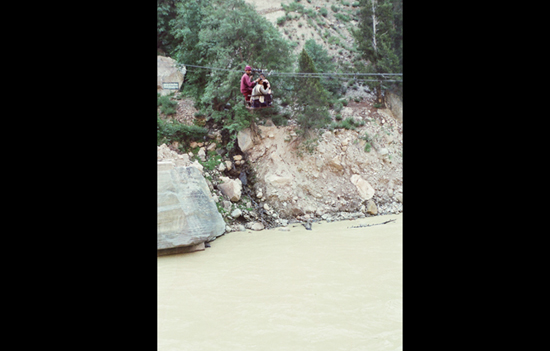 River Sutlej flows through Kinnaur district, Himachal Pradesh. 2001
River Sutlej flows through Kinnaur district, Himachal Pradesh. 2001
Beas originates from a
kund at Rohtang Pass, Himachal Pradesh. Note that Rajasthan gets maximum water
from Pong Dam (Kangra district of Himachal) i.e. on river Beas.
Ravi
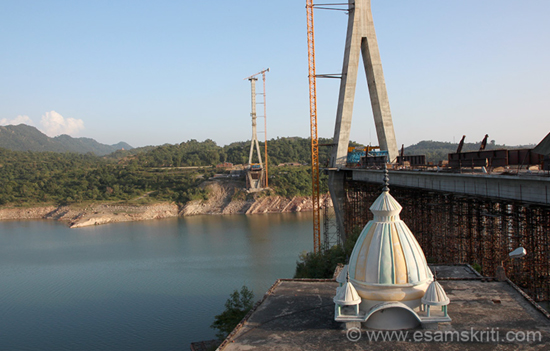 Bridge being built over river Ravi at Basholi, UT of J&K. 2014
Bridge being built over river Ravi at Basholi, UT of J&K. 2014
“The Ravi has its source in Kullu hills near the Rohtang Pass in Himachal Pradesh. After crossing Chamba, it takes a south-westerly turn and cuts a deep gorge in the Dhaola Dhar range. It enters Punjab Plains near Madhopur.” Source
Ravi enters Punjab near Pathankot district before flowing into Pakistan.
The
Ranjit Sagar Dam is located over river Ravi near village Thein in the UT of
Jammu and Kashmir and is the result of a 1979 agreement between Himachal,
Punjab and J&K.
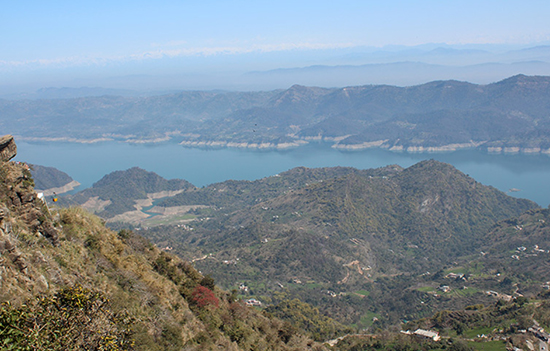 Govind Sagar as viewed from Naina Devi, Himachal.
Govind Sagar as viewed from Naina Devi, Himachal.
Bhakra Dam (built on Sutlej River) has its genesis in the 1960 Indus Water Treaty where waters of Ravi, Sutlej and Beas were allotted to India for exclusive use while Jhelum, Chenab and Indus were for Pakistan’s use with a clause that allowed India limited
rights to generate electricity and irrigation facilities. Thus
besides Bhakra, Pong Dam across Beas Project and Thein
Dam over Ravi were made.
The Nangal dam is on Sutlej river at Nangal i.e. 13 kms below the Bhakra dam. The Bhakra project was a joint venture between Punjab (undivided) and Rajasthan. Cost was shared proportionately based on benefits expected.
Since three rivers are meant for India’s exclusive use under the 1960 Treaty, the question that arises, Is India fully utilising
the waters of these rivers? Read on.
Jhelum
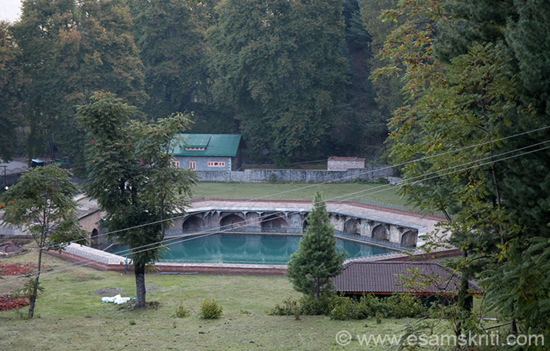 River source is Kund in Verinag, UT of J&K. 2014.
River source is Kund in Verinag, UT of J&K. 2014.
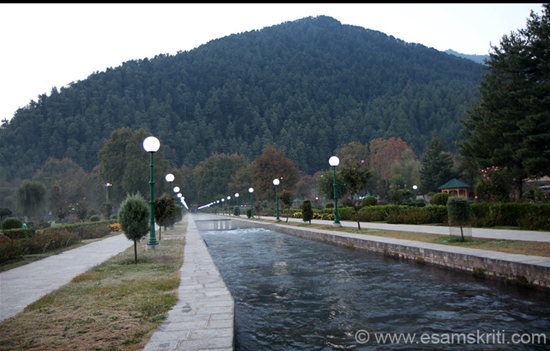 River flowing out of kund at Verinag. 2014.
River flowing out of kund at Verinag. 2014.
The river originates from a kund in Kashmir Valley in the Union Territory of Jammu and Kashmir. “It joins the Chenab at Trimmu.”
Chenab
![]()
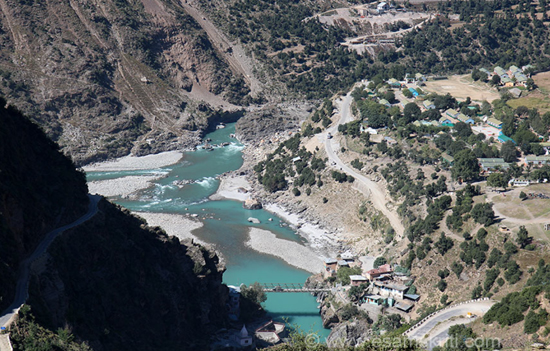 On the right you see river Chenab flowing and from below is Paddar river. Where they join is Bhandarkut Sangam. Pic close to Kishtwar in UT of J&K. 2014
On the right you see river Chenab flowing and from below is Paddar river. Where they join is Bhandarkut Sangam. Pic close to Kishtwar in UT of J&K. 2014
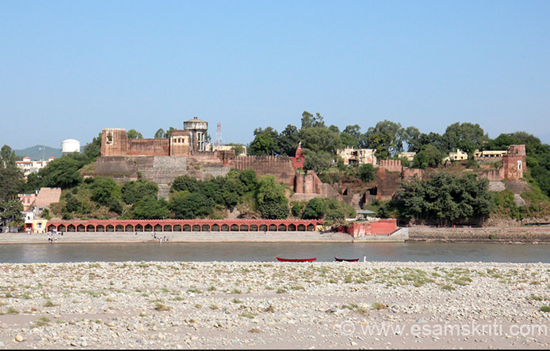 Chenab in front of Akhnoor Fort in UT of J&K. 2014
Chenab in front of Akhnoor Fort in UT of J&K. 2014
“The Chenab originates from near the Bara Lacha Pass in the Lahul-Spiti part of the Zaskar Range. Two small streams on opposite sides of the pass, namely Chandra and Bhaga, form its headwaters at an altitude of 4,900 m. The united stream Chandrabhaga flows in the north-west direction through the Pangi valley, parallel to the Pir Panjal range. Near Kistwar (see above pics), it cuts a deep gorge. It enters the plain area near Akhnoor in Jammu and Kashmir.” Source Eventually the Chenab flows into Pakistan.
Today none of the five
rivers originate in modern day Punjab.
Q3. Then, why the name Punjab?
A3.
Author, historian and former British Council Scholar Dr Satish K Kapoor wrote
in Punjab
Monitor, “During the Vedic age, Punjab was known as Sapta Sindhu or the land of seven rivers. It was
then inhabited by the Panchajanas or
five major tribes. During the epic age Punjab was known as Panchnad or the land of five rivers. The word “Panchnad” is the Sanskrit form of the Persian expression "Punjab" and the Greek version “Pentapotamia.” During the Medieval age, Punjab was famous as the Suba
of Lahore. When Maharaja Ranjit Singh ascended the throne, Punjab became famous as the Kingdom of Lahore. However, after the British occupation in 1849, it was given back the name of the province of Punjab.”
Note
that till the earthquake of 1809 the river Indus flowed to Lakhpat in Kutch
(today Sindh) from where it flowed into the Arabian Sea.
Q4. It can be argued that Haryana, Himachal and Jammu and
Kashmir were part of Punjab at some point.
A4. If we were to use this logic North West Frontier Province was part of Punjab till 1901 and Maharaja Ranjit Singh’s Empire included parts of current day Pakistan and Afghanistan. Source
We
need to look at the current geography of Punjab and not what existed earlier. After
all, since 1957, Akalis started to demand a state where Punjabi, in Gurumukhi
script, would be the state language (linguistic states was the norm then).
Thus, the existing border.
Recently “the Supreme
Court upheld validity of Haryana Gurdwaras Act, dismissing SGPC’s (Shiromani Gurudwara Prabandhak Committee) plea that the Sikh Gurdwaras Act, 1925 be applicable, which empowers SGPC to manage and control Sikh shrines in Haryana.”
Q5. What about the farmers claim that India is a not utilising
its share of waters, allowing water to
flow to Pakistan and the Indus Water Treaty?
A5.
Firstly, what are the key provisions of the treaty?
Lt
Gen Pramod Grover wrote
in Tribune Chandigarh, “First, it allocates the water of the three western rivers to Pakistan, but allows India to tap the considerable hydropower potential before the rivers enter Pakistan. Second, the treaty allowed India to create storage on the western rivers of 1.25, 1.60, and 0.75 MAF (million acre feet) for general, power, and flood storages, respectively, amounting to total permissible storage of 3.6 MAF. Third, the treaty does not require India to deliver assured quantities of water to Pakistan and instead it requires India to let flow to Pakistan the water available in these rivers excluding the limited use permitted to India by the treaty. Fourth, there are no quantitative limits to the hydroelectricity that India can produce using the western rivers nor any limit to the number of run-of-the-river projects India can build.”
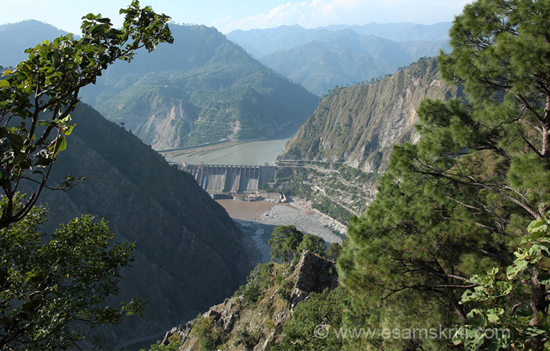 Salal Dam on Chenab river, near Jammu in UT of J&K. 2014
Salal Dam on Chenab river, near Jammu in UT of J&K. 2014
So has India utilised it share of waters of rivers?
Lt Gen Grover also wrote, “Of the 1.34 million acres permitted for irrigation, India is using only 0.792 million acres. Out of an assessed potential of 18,653 MW, only projects worth 3,264 MW have been commissioned so far.” So Pakistan is getting bonus flows.
A
Parliamentary Committee report
in Tribune Chandigarh (July 2022) says, “Took note of inadequate work done to harness the waters of Indus, Jhelum, and Chenab (western rivers) which largely flows into Pakistan. For instance, India as per the Indus Water Treaty can create water capacity storage upto 3.6 Million Acre-Feet (MAF) on Western rivers but no storage capacity has been created so far.”
It also states that, “The government must renegotiate the Indus Water Treaty with Pakistan because present day pressing issues such as climate change, global warming and environmental impact assessment were not taken into account when the pact was signed in 1960.” Geostrategist Brahma Chellaney wrote Rework
the terms of the Indus Water Treaty
All governments since 1960 are responsible for
underutilization of waters.
According to a November 2018 report, India decided to fast-track three projects which includes
construction of two dams. The three projects are the Shapur Kandi dam project
(by Punjab and J&K), a second Sutlej-Beas link in Punjab and Ujh Dam
project in the UT of Jammu and Kashmir.
Can the central government give a quarterly status report on these three projects and a plan to fully utilise India’s share of waters?
Inspite of receiving 80.52% of the Indus system waters under the 1960 treaty Pakistan
demands a bigger share. Why is a separate topic?
Also read Water
mismanagement in Pakistan N Water
crisis in Pakistan
Q6 Why only 27% of Punjab land is irrigated by canals?
A6
Answer to this would require a separate study. Suffice to say that state
governments, across party lines, have focused on appeasing farmers with free
power (since 1997-98) and farm loan waivers leaving little money for irrigation
facilities. Plus Sikh terrorism in the 1980s set Punjab back by years.
Note
that the power subsidy bill in Fy23 is Rs
15,845 crs. This and other
freebies leaves fewer
resources for needy programs in an agrarian state. Also read RBI
Report on State Finances-Punjab worst hit
N Here
Moneycontrol
A well designed canal web covering 100% of farmland would be a good investment. “If covered with solar panels and interspersed with micro-hydels it would also generate cheap electricity.”
Does the Punjab government
have the vision and the money?
Q7. Irrigation is a state subject!
A7.
States have no qualms in taking advantage of
centrally sponsored schemes yet argue that agriculture is a state subject.
According to a Tribune report on Punjab Budget 2020-21, officials admit dependence on grants from the Centre for various centrally sponsored schemes. “Punjab’s former Chief Minister Amarinder Singh asked the Centre to create a fund of around Rs 25,000 crore to help farmers switch from paddy to maize.” Source Indian Express I am not even talking of Fertiliser subsidy and Rs 6,000/- given to farmers annually both of which are funded by the Centre.
Q8. Water crisis in Punjab!
A8. Free power has hurt Punjab’s agriculture, depleted water resources by encouraging paddy cultivation, added to farmers’ production cost by forcing the installation of submersible pumps and curtailed industrial activity during the paddy season.
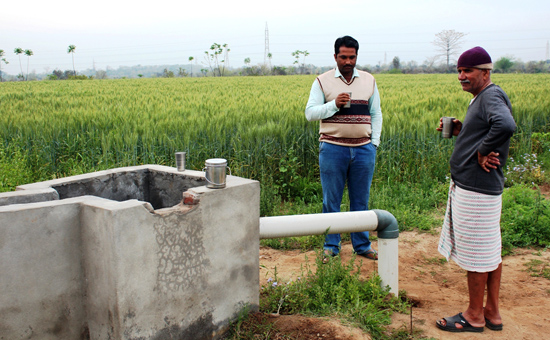 Using groundwater in Punjab.
Using groundwater in Punjab.
In fact farmers might know that, according to a draft report of the Central Ground
Water Board (North-Western region), Punjab will be rendered a desert within 25
years if the exploitation of its underground water
resources continues at the current rate. Source
Also read Groundwater
misuse may rise manifold in Punjab due to lower charges N
Punjab
tops the country in over-exploitation of ground water
Farmers of Punjab,
politicians across parties and higher Judiciary need to be explained the new
reality so that emotions are not raised. Else innocent people might lose their
livelihood and lives.
Two out of the three causes for Punjab’s crisis i.e. water crisis and environmental pollution are caused by farmers themselves. They will not talk of that because many believe attack is the best form of defence (hence agitation). Unless this agitation has different motives!
On
Pollution read How Punjab’s misplaced agricultural priorities causes problem in NCR and
Free
Power, MSP and Cancer - Is Punjab dying
Instead of agitation, farmers need to be professional, scientific and commercial in their business of farming! There is no compulsion to farm. Those who can't should quit and learn some other skill.
Also read
1.
Rivers of
Himachal
2.
Eight Major
Dams of India including in Himachal and Punjab
3.
Indus
Water turns 60, disputes persist
4.
Rationing
of water is a must for sustainability
5.
What
is the problem in Punjab
6.
Punjab’s economy needs reforms
7.
Use of Pesticides – Cancer Train
8.
Free
power to Punjab farmers, one of the causes of pollution in NCR
9.
Rationing
of water a must for sustainability
10.
Ashok
Gulati art has Map of Depth of Water Level in Punjab 1985 vs 2019.
11. Harvesting
Water Technology
12. About
Maharaja Ranjit Singh
13. Why
was Bhakra Nangal Dam made
All article pictures by Author and copyright esamskriti.com. This article cannot be re-published without written permission of esamskriti.com